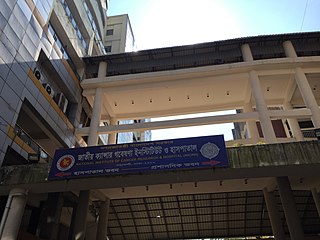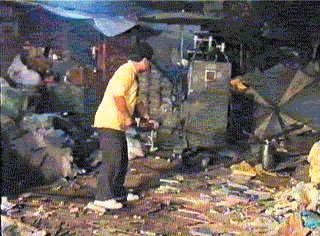Related Research Articles

Radiation therapy or radiotherapy, often abbreviated RT, RTx, or XRT, is a therapy using ionizing radiation, generally provided as part of cancer treatment to control or kill malignant cells and normally delivered by a linear accelerator. Radiation therapy may be curative in a number of types of cancer if they are localized to one area of the body. It may also be used as part of adjuvant therapy, to prevent tumor recurrence after surgery to remove a primary malignant tumor. Radiation therapy is synergistic with chemotherapy, and has been used before, during, and after chemotherapy in susceptible cancers. The subspecialty of oncology concerned with radiotherapy is called radiation oncology. A physician who practices in this subspecialty is a radiation oncologist.

External beam radiation therapy (EBRT) is a compound word that refers to the use of a collimated beam of ionizing radiation from outside the body to treat a disease.
Radiation dosimetry in the fields of health physics and radiation protection is the measurement, calculation and assessment of the ionizing radiation dose absorbed by an object, usually the human body. This applies both internally, due to ingested or inhaled radioactive substances, or externally due to irradiation by sources of radiation.

A nuclear and radiation accident is defined by the International Atomic Energy Agency (IAEA) as "an event that has led to significant consequences to people, the environment or the facility. Examples include lethal effects to individuals, large radioactivity release to the environment, reactor core melt." The prime example of a "major nuclear accident" is one in which a reactor core is damaged and significant amounts of radioactive isotopes are released, such as in the Chernobyl disaster in 1986 and Fukushima nuclear disaster in 2011.

Radiosurgery is surgery using radiation, that is, the destruction of precisely selected areas of tissue using ionizing radiation rather than excision with a blade. Like other forms of radiation therapy, it is usually used to treat cancer. Radiosurgery was originally defined by the Swedish neurosurgeon Lars Leksell as "a single high dose fraction of radiation, stereotactically directed to an intracranial region of interest".
A monitor unit (MU) is a measure of machine output from a clinical accelerator for radiation therapy such as a linear accelerator or an orthovoltage unit. Monitor units are measured by monitor chambers, which are ionization chambers that measure the dose delivered by a beam and are built into the treatment head of radiotherapy linear accelerators.
Harold Elford Johns was a Canadian medical physicist, noted for his extensive contributions to the use of ionizing radiation to treat cancer.

Cobalt-60 (60Co) is a synthetic radioactive isotope of cobalt with a half-life of 5.2713 years. It is produced artificially in nuclear reactors. Deliberate industrial production depends on neutron activation of bulk samples of the monoisotopic and mononuclidic cobalt isotope 59
Co
. Measurable quantities are also produced as a by-product of typical nuclear power plant operation and may be detected externally when leaks occur. In the latter case the incidentally produced 60
Co
is largely the result of multiple stages of neutron activation of iron isotopes in the reactor's steel structures via the creation of its 59
Co
precursor. The simplest case of the latter would result from the activation of 58
Fe
. 60
Co
undergoes beta decay to the stable isotope nickel-60. The activated nickel nucleus emits two gamma rays with energies of 1.17 and 1.33 MeV, hence the overall equation of the nuclear reaction is:
Radionuclides which emit gamma radiation are valuable in a range of different industrial, scientific and medical technologies. This article lists some common gamma-emitting radionuclides of technological importance, and their properties.

The National Oncologic Institute or ION is a specialized hospital for cancer treatment, located in Panama City, Panama. Between August 2000 and March 2001, patients receiving radiation treatment for prostate cancer and cancer of the cervix received lethal doses of radiation, resulting in eight fatalities.

Riverside Methodist Hospital is the largest member hospital of OhioHealth, a not-for-profit, faith-based healthcare system located in Columbus, Ohio.

Cobalt therapy is the medical use of gamma rays from the radioisotope cobalt-60 to treat conditions such as cancer. Beginning in the 1950s, cobalt-60 was widely used in external beam radiotherapy (teletherapy) machines, which produced a beam of gamma rays which was directed into the patient's body to kill tumor tissue. Because these "cobalt machines" were expensive and required specialist support, they were often housed in cobalt units. Cobalt therapy was a revolutionary advance in radiotherapy in the post-World War II period but is now being replaced by other technologies such as linear accelerators.
The 1990 Clinic of Zaragoza radiotherapy accident was a radiological accident that occurred from 10 to 20 December 1990, at University Clinic Hospital Lozano Blesa of Zaragoza, in Aragon, Spain.

The radiotherapy accident in Costa Rica occurred with the Alcyon II radiotherapy unit at San Juan de Dios Hospital in San José, Costa Rica. It was related to a cobalt-60 source that was being used for radiotherapy in 1996. An accidental overexposure of radiotherapy patients treated during August and September 1996 was detected. During the calibration process done after the change of 60Co source on 22 August 1996, a mistake was made in calculating the dose rate, leading to severe overexposure of patients. The error of calibration was detected on 27 December 1997. In the course of the accident, 114 patients received an overdose of radiation and 13 died of radiation-related injuries.
Uganda Cancer Institute (UCI) is a public, specialized, tertiary care medical facility owned by the Uganda Ministry of Health. The facility is located along Upper Mulago Hill Road, on Mulago Hill, in the Kawempe Division of Kampala, about 4.5 kilometres (2.8 mi) north of the central business district of the city. The geographical coordinates of the institute are: 00°20'29.0"N, 32°34'40.0"E.

National Institute of Cancer Research & Hospital (NICRH) is dedicated to cancer patient management, education and research. This is the only tertiary level center of the country engaged in multidisciplinary cancer patient management. It started its activity in a tin-shade building of Dhaka Medical College and Hospital in 1982, soon it is shifted to the present location at Mohakhali in 1986. According to a Memorandum of Understanding signed between the Ministry of Health and the Rotary Club of Dhaka the latter built the Rotary Cancer Detection Unit (RCDU) and the Cancer Institute started working as an outdoor cancer detection unit only. In 1991, 50 bed indoor facilities incorporated. In 1994 the cancer institute renamed as National Institute of Cancer Research & Hospital (NICRH) and the first radiation treatment was applied to a patient in 1995 with a Cobalt 60 Teletherapy machine. With the provision of support from the Saudi Fund for Development (SFD), the up-gradation works of this Institute to 300 bedded Center has been completed. In April 2015 it was upgraded to a 300-bed hospital. In 2019 the Hon'ble Health Minister Mr. Jahid Maleque M.P. consented to convert NICRH as a 500-bed hospital and the work is almost completed.

A radiation accident occurred in Samut Prakan Province, Thailand in January–February 2000. The accident happened when an insecurely stored unlicensed cobalt-60 radiation source was recovered by scrap metal collectors who, together with a scrapyard worker, subsequently dismantled the container, unknowingly exposing themselves and others nearby to ionizing radiation. Over the following weeks, those exposed developed symptoms of radiation sickness and eventually sought medical attention. The Office of Atomic Energy for Peace (OAEP), Thailand's nuclear regulatory agency, was notified when doctors came to suspect radiation injury, some 17 days after the initial exposure. The OAEP sent an emergency response team to locate and contain the radiation source, which was estimated to have an activity of 15.7 terabecquerels (420 Ci), and was eventually traced to its owner. Investigations found failure to ensure secure storage of the radiation source to be the root cause of the accident, which resulted in ten people being hospitalized for radiation injury, three of whom died, as well as the potentially significant exposure of 1,872 people.
Docrates Cancer Center is the first and currently the only private hospital in the Nordic countries that comprehensively specialises in cancer treatment. It operates in Helsinki, Finland. It characterises its operations as those complementing the public sector. Docrates Oy was established in 2006 and the hospital started its operations at the premises of Eira Hospital in autumn 2007. It moved to its own premises in Jätkäsaari, Helsinki, in 2009, where it has hospital rights. There is a ward and Health and Recovery Center located at Docrates Cancer Center. Among other things, diagnostics, pharmacotherapy, radiation therapy and isotopic treatments are carried out at the hospital. Cancer surgeries are performed in partner hospitals. Docrates also participates in clinical trials and the testing and development of new treatments.

Panacea Medical Technologies, headquartered in Bangalore, India is a developer, manufacturer and healthcare service provider of radiotherapy and radiology equipment for the diagnosis and treatment of cancer.
References
- 1 2 3 4 "The Riverside Radiation Tragedy". Columbus Monthly. 2014-02-06. Archived from the original on 2019-09-24. Retrieved 2021-05-08.
- 1 2 3 Valentin, J (2000). "Case histories of major accidental exposures in radiotherapy". Annals of the ICRP. SAGE Publications. 30 (3): 23–29. doi: 10.1016/s0146-6453(01)00039-2 . ISSN 0146-6453.
- 1 2 3 Almond, Peter (2013). Cobalt Blues : The Story of Leonard Grimmett, the Man Behind the First Cobalt-60 Unit in the United States. New York, NY: Springer. p. 113. ISBN 978-1-4614-4923-2. OCLC 820724368.
- ↑ Nénot, J-C (2002). Second Henri Jammet Memorial Lecture. Radiation Accidents - an Overview and Feedback, 1950 - 2000. 8th Coordination Meeting of World Health Organization Collaborating Centres in Radiation Emergency Medical Preparedness and Assistance Network, REMPAN.
- ↑ Ricks, Robert C.; Berger, Mary Ellen; Holloway, Elizabeth C.; Goans, Ronald E. (2000). REAC/TS Radiation Accident Registry: Update of Accidents in the United States (PDF). International Congress of the International Radiation Protection Association 10. Hiroshima, Japan: Japan Health Physics Society. Archived from the original (PDF) on 2021-02-24.